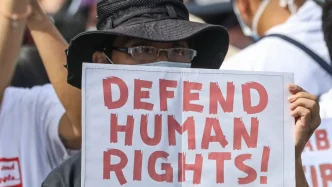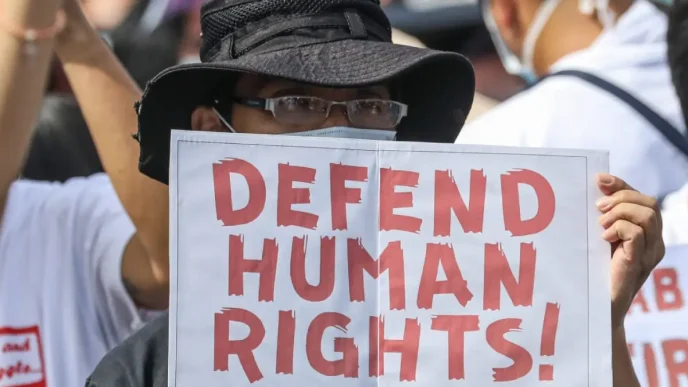In a bold display of sovereignty, personnel from the Philippine Navy, Philippine Coast Guard, and Philippine National Police Maritime Group raised the national flag on Pag-asa Cay during a maritime operation on April 27, 2025. The operation, conducted across Pag-asa Cay 1, Cay 2, and Cay 3 in the disputed West Philippine Sea, directly challenges recent claims by China of control over nearby Sandy Cay, known as Tiexian Reef. This move underscores Manila’s determination to assert its jurisdiction over the contested waters of the South China Sea, a region fraught with geopolitical tensions.
Operation Reinforces Philippine Presence
The Inter-Agency Maritime Operation (IAMO), as described by the National Task Force West Philippine Sea (NTF-WPS), is part of routine efforts to maintain maritime domain awareness and jurisdiction in the West Philippine Sea, the Philippine term for the portion of the South China Sea within its exclusive economic zone. The operation involved deploying forces early on Sunday morning to the cays, carrying the Philippine flag as a visible symbol of authority.
Commodore Jay Tarriela, spokesperson for the Philippine Coast Guard on West Philippine Sea matters, emphasized the significance of the operation in an interview with Radyo 630. “The statement of NTF-WPS yesterday proves that China’s statement that it already occupied the Pag-asa cays is not actually factual” he said. He further noted that the presence of Philippine forces on the cays serves as “clear evidence” that Manila retains access and control, countering what he described as a misleading narrative from Beijing.
Tarriela also clarified that the Chinese Coast Guard is not “permanently occupying” Sandy Cay, a small sandbank within the Spratly Islands, despite recent claims from Chinese state media. This assertion aligns with Manila’s broader stance that its activities in the region are lawful and within its sovereign rights.
China’s Claims and Philippine Response
On Sunday, April 27, 2025, Beijing’s state media reported that the Chinese Coast Guard had implemented “maritime control” over Tiexian Reef, claiming to have landed on Sandy Cay to “exercise sovereignty and jurisdiction.” The report further stated that Chinese forces conducted an “inspection” and collected “video evidence regarding the illegal activities of the Philippine side.” These claims have escalated tensions, prompting a sharp rebuttal from Philippine officials.
National Security Council Assistant Director General Jonathan Malaya, speaking at a press conference on Monday, reminded China of its obligations under the 2002 Declaration on the Conduct of Parties in the South China Sea, a non-binding agreement aimed at preventing conflict in the region. “We remind them of their commitment in the 2002 declaration on the conduct, wherein it was agreed by those nations that signed the declaration that there will be no occupation moving forward of unoccupied features” Malaya said. He urged China and its coast guard to maintain the status quo in the West Philippine Sea and adhere to the principles they have publicly endorsed.
Malaya also called on Beijing to cease provocative actions in the disputed waters. “It is not to the benefit of any nation if these things are happening, nor is it to the benefit of any nation if such irresponsible announcements and statements are released to the public and to the world” he stressed. His remarks reflect growing frustration in Manila over what it perceives as aggressive posturing by China in a region critical to trade, resources, and regional stability.
Geopolitical Context of the South China Sea Dispute
The South China Sea, one of the world’s busiest maritime routes, is a hotspot of competing territorial claims involving China, the Philippines, Vietnam, Malaysia, Brunei, and Taiwan. China claims nearly all of the sea under its expansive “nine-dash line,” a stance rejected by an international tribunal in 2016 under the United Nations Convention on the Law of the Sea (UNCLOS). The Philippines, bolstered by the ruling, has sought to reinforce its claims through diplomatic efforts and on-the-ground operations like the recent IAMO.
Pag-asa Cay, also known as Thitu Island, is the largest of the Philippine-occupied features in the Spratly Islands and hosts a small civilian community alongside military personnel. Its strategic location makes it a focal point in the broader dispute, often drawing attention from both Philippine and Chinese forces. Sandy Cay, located nearby, remains a contentious area due to its proximity to Pag-asa and its status as an unoccupied feature, which both sides have sought to influence.
China’s increasing assertiveness in the region, including the deployment of coast guard vessels and fishing fleets often described as militia by neighboring states, has heightened tensions. Incidents of harassment against Philippine fishing boats and resupply missions to troops stationed in the Spratlys have become more frequent, prompting Manila to strengthen its maritime presence with support from allies like the United States and Japan.
Domestic and International Implications
Domestically, the Philippine government’s actions at Pag-asa Cay are likely to resonate with a public increasingly vocal about defending national sovereignty. President Ferdinand Marcos Jr. has taken a firmer stance against China compared to his predecessor, Rodrigo Duterte, emphasizing the importance of protecting the country’s maritime rights. Operations like IAMO serve not only as practical assertions of control but also as symbolic gestures to rally national support.
Internationally, the operation and the ensuing war of words with Beijing highlight the challenges of maintaining stability in the South China Sea. The United States, a treaty ally of the Philippines, has repeatedly affirmed its commitment to defend Manila under the 1951 Mutual Defense Treaty, which includes attacks on Philippine forces in the region. Recent joint military exercises between the two nations, as well as trilateral cooperation with Japan, signal a growing network of alliances aimed at countering China’s influence.
However, the risk of miscalculation remains high. A direct confrontation between Philippine and Chinese forces could escalate into a broader conflict, drawing in external powers and disrupting vital trade routes. Analysts suggest that while Manila’s operations are within its rights, they may provoke further retaliatory actions from Beijing, such as increased patrols or blockades around disputed features.
Broader Regional Dynamics
The dispute over Pag-asa Cay and Sandy Cay is emblematic of wider regional dynamics, where smaller nations like the Philippines navigate the power imbalance with China. Vietnam, another claimant in the South China Sea, has also faced similar challenges, with frequent standoffs over fishing rights and oil exploration. Hanoi’s response to the current situation could provide insight into potential ASEAN (Association of Southeast Asian Nations) coordination on the issue, though the bloc remains divided due to economic ties with China.
Meanwhile, international observers note that China’s narrative of control over Sandy Cay, if unchallenged, could set a precedent for further encroachments on unoccupied features, undermining the 2002 Declaration on the Conduct. The Philippines’ proactive stance, therefore, carries significance beyond its borders, potentially influencing how other claimants respond to Beijing’s actions.
Looking Ahead
As tensions simmer in the West Philippine Sea, the Philippine government faces the delicate task of balancing assertiveness with diplomacy. While operations like the one at Pag-asa Cay bolster national pride and reinforce legal claims, they also risk escalating an already volatile situation. The coming weeks may reveal whether dialogue, possibly through ASEAN channels or direct talks with China, can de-escalate the standoff—or whether the region is headed for further confrontation.
For now, the Philippine flag flying over Pag-asa Cay stands as a defiant symbol of resilience. Yet, with China’s unwavering claims and growing military presence, the path to a lasting resolution in the South China Sea remains as murky as the waters themselves.














